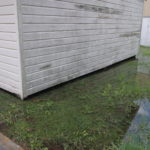As the school year comes to end, most of our readers are preparing for the mad rush of numerous maintenance projects that come when students and teachers leave. However, before they go here are some tips to get you through the next month and help you prepare for summer as well.
Moisture Monitoring

Poor drainage can allow mosquitoes to breed, and make the building susceptible to other pests. Look for ways to reduce this in your area.
This spring has been extremely wet. With the increased moisture in the air and the soil, there are a lot of pests that will be showing up. This is a good time to remind staff as they have their end of year festivities to be on the lookout for any areas that are showing water spots. Does an area smell musty that didn’t before? Are they seeing new insect pests showing up in restrooms, classrooms on exterior walls, little differences that might not seem like a lot now, could present themselves later this fall as bigger problems. Reminding everyone their role in the IPM and IAQ (Indoor Air Quality) programs at a time like this will make them appreciate your efforts in the fall.
Clutter Removal

This lost and found pile of clothing along with excess cardboard is a great place for bed bugs, cockroaches and mice to thrive.
Be sure to encourage teachers, staff, and students to discard items that they will not need next year. End of the school year is a good time to remind PTA/PTO groups to clean out the closets and toss those old items. Teachers should help students to clean out desks, lockers or other areas where they are known to ‘store’ items, so they go home. Have a bunch of stuff to clean out – think about another group within your community you could donate to. I have often seen the ‘pile’ of lost and found at schools become a mountain, if no one is willing to claim, then why not donate to a homeless shelter instead? Remember this clutter can become a home to mice, cockroaches, ants and mold so keeping everything tidy is good for all.
Outdoor awareness
This is the time of year for picnics, BBQs, and graduations, which also means mosquitoes, ants, and ticks to name a few of our favorite pests. Personal protection and awareness to areas means being prepared to face certain problems. For outdoor events schools can determine a policy that allows for parents to provide mosquito and tick repellent to their children. For certain classes that require outdoor exposure it might be wise to work with teachers and administrators to ensure student safety is considered. Remember the 4 D’s
- DUSK/DAWN – Stay indoors at Dusk/Dawn. This is the time of day that mosquitoes are most active, so if you can’t stay inside then DO cover up.
- DEET- Use insect repellents that contain DEET when going outside, especially at times closer to dawn or dusk when mosquitoes are most active. If you are not a fan of DEET, there are other repellents you can use, so use one!
- DRAIN – Remove all areas of standing water. Examples are pet dishes, empty soda cans, and water trays under potted plants. Repair faulty French drains, so the water doesn’t stand. Remove debris from rain gutters. Mosquitoes will breed in this debris since it is normally damp under the debris. Remove all piles of dead leaf material from under trees and shrubs; this also is a breeding site.
- DRESS – Avoid being bitten by mosquitoes by wearing light-colored long-sleeved shirts and long pants when going outside. You can also purchase mosquito suits which is a fine mesh netting that can be worn over your clothes.
Another pest to be aware of outdoors is snakes. Remind everyone to watch for those that slither in tall grassy areas, or where there could be a large wildflower population. The small mammals and birds that use those areas for nesting and eating (food & harborage) are also places for larger prey to lurk as well.
For more information on ways to help your IPM program check out these links:
Mosquito Control Methods and other information pertaining to repellents and mosquito diseases as well.
Integrated Mosquito Management Plan – basic information to help you and others prevent mosquitoes in your area.
Texas Parks and Wildlife has a great website on Venomous Snake Safety and what are the 15 snakes you should know. Another good resource is the Herps of Texas website herpetology is the study of amphibians and reptiles and this website has a full list of the snakes you will find in TX.
 Here is a past newsletter article from Dr. Merchant on Fleas and Ticks that will help you learn more about management and control of these pests. In this article from 2016 Ticks to look out for – by southern states can help you determine what tick species you have. And remember you can visit our TickApp site to answer all your questions about ticks.
Here is a past newsletter article from Dr. Merchant on Fleas and Ticks that will help you learn more about management and control of these pests. In this article from 2016 Ticks to look out for – by southern states can help you determine what tick species you have. And remember you can visit our TickApp site to answer all your questions about ticks.
(Note in some cases when you go to open the website in your web browser you might be asked to verify a certificate – DON’T hit Cancel and the site will load. We have a quirk that we are trying to work out.)

 .
.